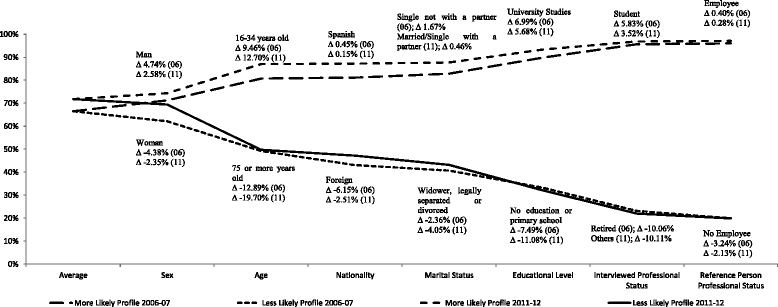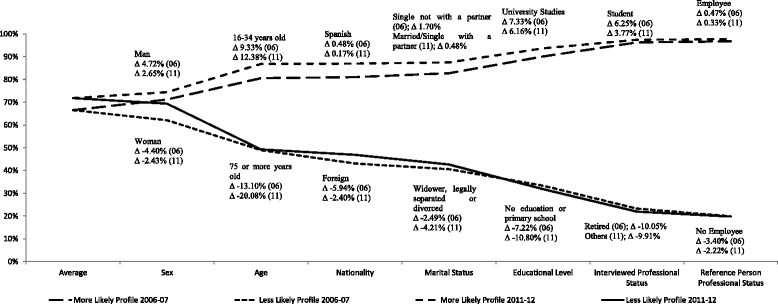Health inequalities by socioeconomic characteristics in Spain: the economic crisis effect
- PMID: 27067675
- PMCID: PMC4827195
- DOI: 10.1186/s12939-016-0346-4
Health inequalities by socioeconomic characteristics in Spain: the economic crisis effect
Abstract
Background: An economic crisis can widen health inequalities between individuals. The aim of this paper is to explore differences in the effect of socioeconomic characteristics on Spaniards' self-assessed health status, depending on the Spanish economic situation.
Methods: Data from the 2006-2007 and 2011-2012 National Health Surveys were used and binary logit and probit models were estimated to approximate the effects of socioeconomic characteristics on the likelihood to report good health.
Results: The difference between high and low education levels leads to differences in the likelihood to report good health of 16.00-16.25 and 18.15-18.22 percentage points in 2006-07 and 2011-12, respectively. In these two periods, the difference between employees and unemployed is 5.24-5.40 and 4.60-4.90 percentage points, respectively. Additionally, the difference between people who live in households with better socioeconomic conditions and those who are in worse situation reaches 5.37-5.46 and 3.63-3.74 percentage points for the same periods, respectively.
Conclusions: The magnitude of the contribution of socioeconomic characteristics to health inequalities changes with the economic cycle; but this effect is different depending on the socioeconomic characteristics indicator that is being measured. In recessive periods, health inequalities due to education level increase, but those linked to individual professional status and household living conditions are attenuated. When the joint effects of individuals' characteristics are considered, the economic crisis brings about a slight increase in the inequalities in the probability of reporting good health between the two extreme profiles of individuals. The design of public policies aimed at preventing any worsening of health inequalities during recession periods should take into account these differential effects of socioeconomic characteristics indicators on health inequalities.
Keywords: Economic recession; Health inequalities; Health status; Socioeconomic characteristics; Spain.
Figures
References
-
- Organización Mundial de la Salud: Comisión sobre Determinantes Sociales de la Salud, conceptos clave. Organización Mundial de la Salud. 2014. http://www.who.int/social_determinants/thecommission/finalreport/key_con.... Accessed 21 February 2014.
Publication types
MeSH terms
LinkOut - more resources
Full Text Sources
Other Literature Sources
Medical



